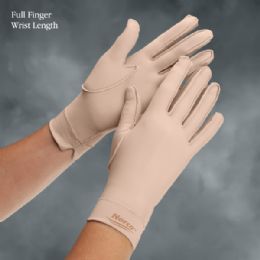
.jpg&newheight=260&quality=80)






Why are Compression Garments Worn?
Compression garments are worn to minimize the risk of blood clots, prevent edema in the extremities, enhance circulation of blood and lymph fluid in patients with vascular disease, and as a common part of post-surgical protocols for operations such as mastectomies and cosmetic procedures such as liposuction to prevent embolisms, hemotomas and lymphedema.
Compression garments are suitable for patients who are immobile for lengthy amounts of time such as those confined to bed while recovering from an illness, injury or surgery. They are also ideal for people living with neuromuscular or musculoskeletal conditions that restrict mobility.
Some garments are uniquely designed for use by children living with autism or sensory processing disorders.
Garments may also be worn to provide upper body support and maintain an upright position in cases of core muscle weakness due to neurological concerns.
Who Wears Compression Garments?
Patients at risk for, or suffering from edema, lymphedema, varicose veins, venous ulcers and insufficiency, and embolisms may find great benefit in wearing compression garments. They are also suitable for wear by those individuals recovering from surgery or confined to bed for extended periods of time due to medical issues. Patients who are non-ambulatory due to orthopedic, neurological, or musculoskeletal issues are positively availed from the enhanced circulation as well.
The constant pressure of the compression hose, sleeves, gloves, vests and pants keeps blood and lymph fluid from pooling in the extremities or at surgical sites and enhances flow toward the heart for post-operative patients and those undergoing treatment for vascular problems. Some garments such as hose and arm sleeves apply graduated pressure that increases toward the hand or the foot. Other designs maintain the same pressurized amount throughout the garment.
Compression shirts and shorts may also be worn by children living with autism, AD/HD, or sensory processing disorders who benefit from gentle pressure that stimulates nerves in the trunk and shoulders to sending calming signals to the brain, allowing them to relax and engage more fully with their surroundings.
Active people may benefit from compression clothing, too. The enhanced circulation mitigates the tired, achy feeling in the muscles after exercise or participation in sports.
How are Compression Garments Worn?
This specially designed apparel is worn on the hands, arms and legs just like regular gloves and stockings. The fabric is more fragile, though, and care must be taken while putting the garments on, taking them off and washing them to avoid creating runs or tears.
When are Compression Garments Worn?
The appropriate use of compression garments varies from patient to patient. Depending on the condition, this special clothing may need to be worn for a relatively short amount of time such as during post-surgical recovery, or the garments may have to be worn on a continuous basis throughout a patient’s life.
Usually, compression garments are not worn while sleeping to allow the skin to breathe, and to afford an opportunity to wash and dry the clothing overnight. Pillows are used to elevate the limbs and encourage healthy circulation during the night time hours.
Compression garments are worn underneath clothes making them appropriate for wear at home, in public or in long-term care facilities such as nursing homes.
Rehabmart carries innovative compression garments from noted vendors including North Coast, SPIO Works, BSN Medical, Bauerfeind and Expand a Band.
Hulet Smith, OT
Rehabmart Co-Founder & CEO
fj